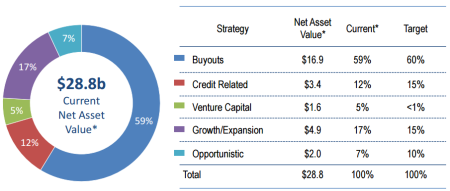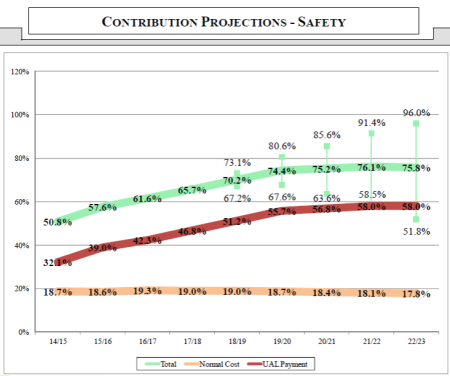Reporter Ed Mendel covered the California Capitol in Sacramento for nearly three decades, most recently for the San Diego Union-Tribune. More stories are at Calpensions.com.
A big question faces a new California board, Secure Choice, as it prepares to recommend an “automatic IRA” to the Legislature for the more than 6 million California private-sector workers not offered a retirement plan on the job.
If a worker is automatically enrolled in a new state-run retirement savings plan, and does not opt out, what happens if the plan’s investments lose money in one or more years?
Last week, the Secure Choice board narrowed its choice to two plans. One is a “dynamic asset allocation” that becomes less risky (and probably lower yielding) near retirement. There is no guarantee against losses, just like private-sector 401(k) plans.
The other plan is a “variable-rate savings bond” that has a “soft guarantee” to reduce but not prevent losses. In years with high yields from a pooled investment fund, some of the returns would be placed in a reserve for use later to offset future losses.
A third plan, said to be out of favor now, is a pension-like “variable annuity” with a guaranteed minimum payment based on peak savings between ages 55 and 65. Costs could be higher and retirement income lower, compared to the other two plans.
In what some call a retirement “crisis,” life spans and health care costs are increasing as Social Security and job retirement plans provide less support, while individual savings are minimal. Two dozen states have considered or enacted state-sponsored retirement plans.
A payroll deduction or “automatic IRA” is said to be a proven way to boost savings. President Obama tried to get Congress to create an “automatic IRA” before launching “MyRA,” a paycheck-deduction for bonds intended to be a “starter” for retirement saving.
The Obama administration gave the “automatic IRA” a big boost last month when U.S. Labor Secretary Tom Perez issued guidelines exempting the plans from a federal pension law (ERISA) that places reporting and other burdens on employers.
An exemption from the federal pension law is required by the legislation that created the Secure Choice program in California. The legislation also requires the state to have no liability for the payment of benefits under the new plan.
But a warning that a wave of new retirement plans, following the ERISA exemption, could create debt for California and other states was issued last month in a Wall Street Journal editorial, mentioned several times at the Secure Choice board meeting last week.
The Journal editorial raised several questions about the legality of the ERISA exemption, calling it “another attempt” by Secretary Perez to rewrite the law without congressional approval.
“To summarize: The Obama Administration is trying to socialize the private retirement investment business by creating subsidized public competition that will be another long-run entitlement burden on taxpayers,” said the Journal editorial.
In California, the legislation that created Secure Choice, despite opposition from taxpayer and financial industry groups, requires the plan to be self-sustaining and to result from a legal and market analysis not funded by the state.
A total of $1 million in donations, half from the Laura and John Arnold Foundation, was raised to hire Overture Financial for the market analysis and K&L Gates for the legal analysis.
The legislation creating Secure Choice (SB 1234 in 2012) was moved through the Legislature, after several previous failures, by Senate President Pro Tempore Kevin de Leon, D-Los Angeles, before he became the Senate leader.
He envisioned a “cash balance” plan similar to the one at the California State Teachers Retirement System, the Defined Benefit Supplement launched in 2000 with a decade-long diversion of a quarter of the teachers’ contribution to the pension plan.
“This type of retirement savings plan has a guaranteed rate of return, and participants would not be exposed on the individual market and vulnerable to the volatility of the unpredictable stock market,” De Leon said in a Senate bill analysis.
At the Secure Choice meeting last week, board member reaction to the cost and complications of the “variable annuity” plan with the guaranteed minimum payment was said to mean it’s not likely to be recommended to the Legislature.
“We see here three doors (plans),” said Mohammad Bakti of Overture Financial. “But in reality we are talking about the first two doors being feasible initially in the program, and the insurance part being more down the line.”
Bakti said modeling shows the “variable rate savings bond” plan with a reserve has the highest long-term returns. But it also has “political risk” from board decisions about crediting interest rates from the pooled fund and investment management.
In an apparent reference to the “dynamic” plan, a K&L Gates attorney, David Morse, told the board he thinks “the simplest approach is the best approach” to get approval from the legislature and the Securities and Exchange Commission.
Morse said his law firm believes that Secure Choice, as a state agency, is exempt from securities law. But he urged the board to seek an SEC letter clearly stating the exemption as a precaution.
“You are taking a risk that either the SEC or a participant would come in and sue, if their investment goes down, especially,” Morse said.
The startup cost of the Secure Choice plan is estimated by Overture to be $73 million, assuming that workers contribute 5 percent of their pay to the savings plan and 25 percent of the workers opt out.
The startup cost is an estimated $129 million if the worker contribution is 3 percent of pay. The legislation caps Secure Choice administrative expenses at 1 percent of total assets, paid from earnings on investments.
Expenses are expected to drop below the 1 percent cap in the fourth year of the program, slowly falling to 0.30 percent after 15 years. Overture said the gap between the cap and the declining expenses could provide the revenue to pay off a startup loan.
Some of the recordkeeping firms that could be hired to administer the Secure Choice program are willing to make a startup loan. But that would limit the choice of administrators to large firms and probably require a long-term contract.
Overture is recommending that the preset option for the worker contribution be 5 percent of pay, adjustable at individual request by percentage or dollar amount. The contribution might increase automatically, which some experts think is important.
The requirement that employers with five or more employees offer Secure Choice, or have an alternative retirement plan, would be imposed in steps over several years, not to exceed 100,000 employers per year.
The nine-member Secure Choice board chaired by state Treasurer John Chiang was expected to give the Legislature a recommendation for a new retirement savings plan by the end of this year.
“I believe the recommendation has to be submitted to the Legislature probably by the end of February,” Christina Elliott, acting Secure Choice executive director, told the board last week.
Photo by TaxCredits.net



























